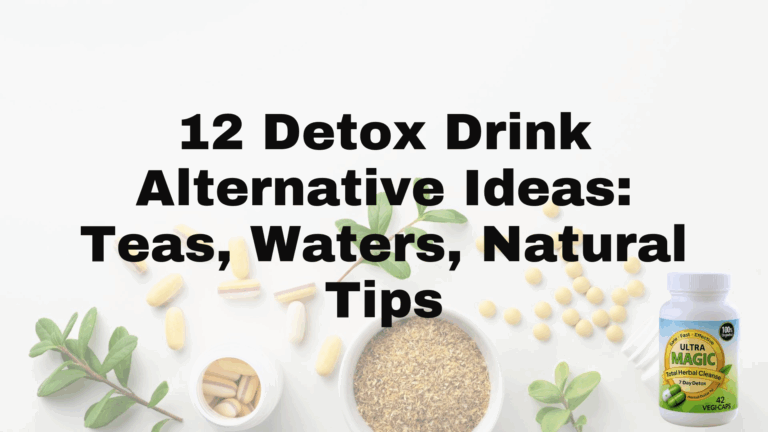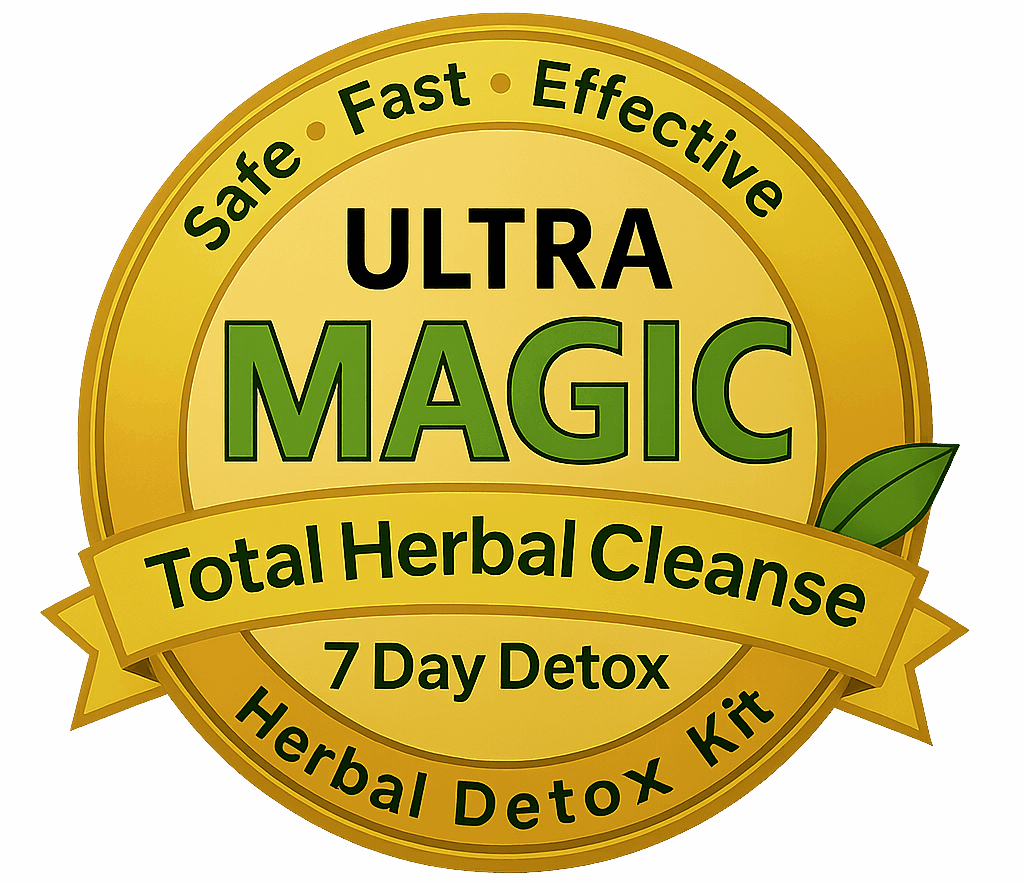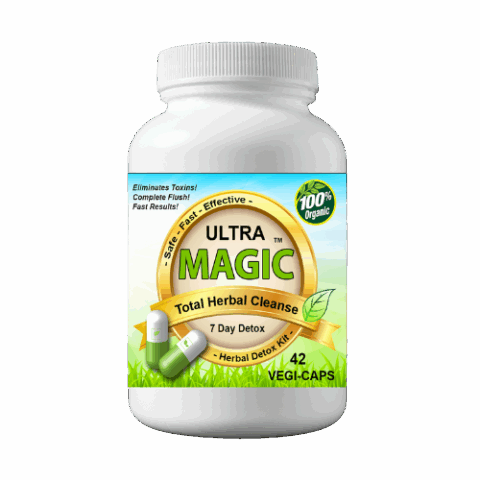
12 Detox Drink Alternative Ideas: Teas, Waters, Natural Tips
Looking for a “detox” without choking down syrupy juice blends or falling for pricey gimmicks? You’re not alone. Many commercial detox drinks are high in sugar, laxatives, or caffeine—and they rarely deliver lasting results. If your real goal is to feel lighter, reduce bloat, support your liver and gut, and maybe nudge along weight goals without wrecking your energy or budget, you need options that are simple, low-sugar, and actually helpful. No single drink can erase toxins overnight, but the right choices can support hydration, digestion, and steady habits that make a difference.
This guide rounds up 12 smart detox drink alternatives you can use right away: clean hydrators like lemon or cucumber water, antioxidant teas, fiber-forward sips, mineral-rich broths, a low-sugar green smoothie, and even a capsule-based herbal option if you prefer a supplement over a drink. For each idea, you’ll get what it is, why it helps, how to make or use it, and safety tips—so you can build a routine that supports your body’s natural detox systems instead of fighting them. Let’s get to the ideas.
1. Ultra Magic Detox (capsules): a powerful detox drink alternative
What it is
Ultra Magic Detox is a capsule-based, herbal formula marketed as a “7‑day permanent cleanse.” It blends 7 organic herbs—burdock root, dandelion root, rhubarb root, goldenseal, sheep sorrel, cat’s claw, and pau d’arco—made in the USA in a GMP-certified, FDA-registered facility, with discreet shipping and a 30‑day money‑back guarantee.
Why it helps as a detox drink alternative
Instead of sugary or laxative-laced beverages, these capsules offer a concentrated, no-sugar option using herbs traditionally used for liver, kidney, and gut support. While your liver and kidneys already do the detoxing, a structured, time-bound protocol can help you stay consistent when you need a reliable plan.
How to make/use it
Take the capsules as directed on the label during the 7‑day protocol, and drink plenty of water. For best results, pair with simple habits:
- Hydrate steadily: Aim for clear-to-pale yellow urine.
- Eat balanced: Prioritize fiber, lean protein, and low-added-sugar foods.
- Cut exposures: Pause alcohol and unnecessary supplements.
Safety and pro tips
Detoxes aren’t a medical necessity for healthy people; consult your clinician if pregnant, nursing, on meds, or managing conditions like diabetes. Stop if you feel unwell, and avoid extreme fasting or megadosing—steady hydration, sleep, and balanced meals make any detox drink alternative work better.
2. Lemon water: simple, low-cost morning reset
What it is
Plain water with a squeeze of fresh lemon—typically a first-thing-in-the-morning sip. No sugar, no frills.
Why it helps as a detox drink alternative
Hydration supports your body’s own detox systems (liver, kidneys) and lemon makes water easier to drink consistently. It also provides vitamin C, and lemon-based drinks are commonly used for light, diuretic-style refreshment.
How to make/use it
Stir the juice of 1/2 lemon into 8–12 oz water (room temp or warm) and drink.
- Morning habit: Sip on waking.
- Keep it simple: Skip added sweeteners.
- Anytime boost: Repeat before meals if you like.
Safety and pro tips
Detoxes aren’t medically required; use lemon water as a hydration habit, not a cure-all. If citrus upsets your stomach, dilute more or use less lemon.
3. Cucumber and mint infused water: cooling hydration
What it is
Lightly flavored water made by steeping sliced cucumber and fresh mint in cold water. It’s unsweetened, refreshing, and easy to keep on hand all day.
Why it helps as a detox drink alternative
Staying hydrated supports your body’s natural detox systems (liver and kidneys). Cucumber and mint make plain water more enjoyable, encouraging steady sipping without sugar, caffeine, or laxatives—key for reducing bloat and maintaining energy.
How to make/use it
Combine 1/2 sliced cucumber + a small handful of mint with 1 quart cold water; chill 30–60 minutes.
- Refill once: Top off the same herbs once, then replace.
- Grab-and-go: Use a lidded bottle with ice.
- Optional: Add lemon or lime slices.
Safety and pro tips
Wash produce well and finish within 24 hours. If mint worsens reflux, skip it. Hydrate to thirst (urine pale yellow) and remember this is a habit booster—not a meal or medical treatment.
4. Green tea or matcha: antioxidant-rich sip
4. Green tea or matcha: antioxidant-rich sip
What it is
Green tea is a brewed, unsweetened tea; matcha is finely milled green tea powder whisked into water for a richer, creamier cup.
Why it helps as a detox drink alternative
MedicineNet notes green tea is often picked for “detox” because of its antioxidant profile. As a practical swap for sugary detox blends, it delivers hydration plus catechins without added sweeteners.
How to make/use it
Steep green tea briefly in hot (not boiling) water to avoid bitterness. For matcha, sift a small amount into a cup, add hot water, and whisk until frothy; enjoy hot or iced.
Safety and pro tips
Green tea and matcha contain caffeine—choose decaf or drink earlier if you’re sensitive. Keep it unsweetened, skip “detox boosters,” and consult your clinician if pregnant, nursing, or on medications.
5. Hibiscus tea: tart, caffeine-free diuretic option
5. Hibiscus tea: tart, caffeine-free diuretic option
What it is
A bright, tart herbal tea made by steeping dried hibiscus flowers in hot water. Enjoy it hot or iced as a naturally unsweetened, flavorful detox drink alternative.
Why it helps as a detox drink alternative
Hibiscus tea is highlighted as a potent, natural diuretic that helps your body excrete excess fluid, which can ease bloating. It’s hydrating, low in calories when unsweetened, and a smart swap for sugary “detox” blends.
How to make/use it
Steep 1–2 teaspoons dried hibiscus in 8–12 oz hot water for 5–10 minutes; strain. Chill for iced tea and add lemon or mint if you like, but skip added sugars. Start with 1–2 cups per day and hydrate normally alongside it.
Safety and pro tips
Because it’s diuretic, expect more frequent bathroom trips—avoid heavy intake right before bed. If you have medical conditions, take medications, or are pregnant or nursing, check with your clinician before making it a daily habit.
6. Ginger tea with lemon: soothing digestion support
What it is
A simple, unsweetened brew made by steeping fresh ginger in hot water and finishing with a squeeze of lemon. It’s warm, aromatic, and easy to sip any time of day.
Why it helps as a detox drink alternative
Warm fluids plus steady hydration support your body’s natural detox systems. Ginger’s heat can feel soothing when you’re bloated or sluggish, while lemon adds flavor and vitamin C—making this a satisfying swap for sugary “detox” drinks.
How to make/use it
Simmer 4–6 thin ginger slices in 10–12 oz water for 5–10 minutes, strain, then add the juice of 1/4–1/2 lemon.
- Morning or post‑meal: Sip warm to settle the stomach.
- Iced option: Chill and pour over ice.
- Keep it clean: Skip sweeteners.
Safety and pro tips
Ginger’s spice can aggravate reflux—use fewer slices or dilute if sensitive. Not a medical treatment; check with your clinician if pregnant, nursing, or on medications. Pair with water, fiber, and sleep for best results.
7. Dandelion root tea: traditional liver-friendly brew
What it is
An herbal tea made by steeping dried or roasted dandelion root. It’s long used in traditional wellness routines.
Why it helps as a detox drink alternative
Hydration supports your liver and kidneys, and dandelion root is traditionally chosen for that role—without sugar, caffeine, or laxatives. It’s a simple, steady, everyday detox drink alternative.
How to make/use it
Brew tea bags per the label, or gently simmer about a spoonful of dried root in hot water, then strain. Enjoy hot or iced, unsweetened, as a mid‑morning or afternoon sip.
Safety and pro tips
Herbal teas aren’t medical detox. If you’re pregnant, nursing, managing a condition, or on medications, talk to your clinician first. Start with a small cup, skip sweeteners, and keep hydrating with plain water.
8. Apple cider vinegar tonic: diluted pre-meal sip
What it is
A simple tart drink made by diluting apple cider vinegar (ACV) in plenty of water. It’s an unsweetened, low‑calorie detox drink alternative you can use as a brief pre‑meal ritual.
Why it helps as a detox drink alternative
It turns plain water into something more interesting, helping you hydrate—key support for your body’s natural detox systems (liver and kidneys). Using it before meals can also encourage a slower, more mindful start instead of chasing sugary “detox” blends.
How to make/use it
Mix ACV with water and keep it unsweetened; never take vinegar straight.
- Basic mix: 1–2 tsp ACV in 12–16 oz cold or warm water.
- Timing: Sip 10–15 minutes before meals, up to 1–2 times daily.
- Flavor options: Add lemon slice or cinnamon stick (no sugar).
Safety and pro tips
Vinegar is acidic—dilute well to reduce throat or stomach irritation. If you have reflux, ulcers, dental sensitivity, are pregnant/nursing, or take medications, check with your clinician; this is a habit aid, not a medical detox.
9. Coconut water: light electrolytes without added sugar
What it is
Unsweetened coconut water is the clear liquid from young coconuts—naturally hydrating with potassium and a small amount of carbs.
Why it helps as a detox drink alternative
Hydration supports your liver and kidneys, and coconut water’s light electrolytes can make steady sipping easier than plain water—without caffeine, laxatives, or the added sugars common in commercial “detox” drinks.
How to make/use it
Drink 8–12 oz chilled on its own or cut 50/50 with water. Add a squeeze of lime, a few mint leaves, or cucumber slices. Use between meals or after light workouts.
Safety and pro tips
Choose unsweetened; read labels. If you have kidney disease, take potassium‑sparing meds, or manage blood sugar, consult your clinician and keep portions modest.
10. Chia or flax water: fiber for fullness
What it is
Plain water mixed with soaked chia seeds or freshly ground flaxseed. When hydrated, these seeds form a gentle gel that turns water into a light, fiber-forward sip.
Why it helps as a detox drink alternative
Fiber supports regularity and helps you feel full, which can curb overeating—an approach several “detox” recipes use with chia or flax. It’s unsweetened hydration that supports your body’s natural detox systems without laxatives.
How to make/use it
- Chia: Stir 1–2 tsp chia into 10–12 oz water; rest 10–20 minutes, then sip.
- Flax: Stir 1 tbsp freshly ground flax into 10–12 oz warm water; drink promptly.
- Timing: Try mid‑morning or 10–15 minutes before meals.
Safety and pro tips
Start small and drink extra water to prevent GI discomfort. Always pre‑soak chia—don’t swallow dry seeds. Separate from medications by 2–3 hours. If you have GI conditions or trouble swallowing, consult your clinician first.
11. Mineral-rich broth: savory, hydrating alternative
What it is
A clear, unsweetened vegetable or chicken broth you sip like tea—warm, savory, and easy on the stomach when sweet drinks don’t appeal.
Why it helps as a detox drink alternative
Hydration supports your liver and kidneys; the light electrolytes (mostly sodium) in broth can make steady sipping easier and ease salty cravings.
How to make/use it
Keep it simple.
- Simmer onion, celery, carrot, herbs, and a pinch of salt; strain.
- Use low‑sodium boxed broth; dilute 1:1 with hot water and sip 8–12 oz between meals.
Safety and pro tips
Not a medical detox—just a practical hydrator.
- Watch sodium if you have hypertension or fluid limits.
- Refrigerate; use within 3–4 days and reheat to steaming.
12. Low-sugar green smoothie: fiber-first blend
What it is
A veggie‑forward smoothie that keeps the fiber you lose in juices. Healthline notes smoothies can be more beneficial than juices because they retain fiber—making this a smarter detox drink alternative you can actually sip for real fullness.
Why it helps as a detox drink alternative
Fiber supports regularity and helps control appetite, while leafy greens and veggies bring antioxidants without a sugar rush (spinach and carrot blends are commonly highlighted for this). Hydration plus fiber beats laxative‑style “detox” drinks for steady, everyday results.
How to make/use it
Blend mostly greens and veggies with just enough fruit for taste; keep it unsweetened.
- Example blend: 1 packed cup spinach, 1 kiwi, 2 small pineapple slices, juice of 1/2 lemon, a few ginger shavings, 8–12 oz water or unsweetened coconut water, ice.
- Optional fiber: 1 tsp chia or 1 tbsp freshly ground flax.
- Timing: Breakfast or 10–15 minutes before lunch.
Safety and pro tips
Keep portions modest (about 12–16 oz). If you manage blood sugar, use minimal fruit and monitor response. Spinach and beets are higher in oxalates; avoid large daily quantities if you’re prone to kidney issues. Skip added sugars and syrups, and consult your clinician if pregnant, nursing, or on medications.
Choose what fits your routine
Pick one or two options you’ll actually use daily, then stack them: hydrate first (lemon or cucumber water), add an antioxidant tea, and get fiber from chia water or a low‑sugar smoothie. Keep meals balanced, go easy on added sugars, sleep well, and let your liver and kidneys do their job. Rotate choices to match the season and your schedule.
If you need a defined, non‑drink option with simple directions, a capsule protocol can help you stay consistent. For a structured 7‑day plan, explore Magic Detox. Pair any choice with steady water intake, light movement, and realistic meals—that’s how “detox” habits turn into lasting results.


